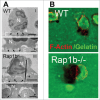Leukocyte transcellular diapedesis: Rap1b is in control
- PMID: 26451346
- PMCID: PMC4574898
- DOI: 10.1080/21688370.2015.1052185
Leukocyte transcellular diapedesis: Rap1b is in control
Abstract
The neutrophil transmigration across the blood endothelial cell barrier represents the prerequisite step of innate inflammation. It is well known that neutrophils cross the endothelial barrier by transmigrating at the endothelial cell junction ('paracellular'). However, in vivo and in vitro evidence have clearly demonstrated occurrence of an alternate mode of migration directly through the endothelial cell body ('transcellular'). Despite our knowledge on mechanisms of transendothelial migration, it remains unclear which factors determine distinct modes of migration. We recently found that the Ras-like Rap1b GTPase limits neutrophil transcellular migration. Rap1b restrains transcellular migration by suppressing Akt-driven invasive protrusions while leaving the paracellular route unaffected. Furthermore, Rap1b limits neutrophil tissue infiltration in mice and prevents hyper susceptibility to endotoxin shock. These findings uncover a novel role for Rap1b in neutrophil migration and inflammation. Importantly, they offer emerging evidences that paracellular and transcellular migration of neutrophils are regulated by separate mechanisms. Here, we discuss the mechanisms of neutrophil transmigration and their clinical importance for vascular integrity and innate inflammation.
Keywords: Rap1b; diapedesis; invadopodia-like protrusions; neutrophil; transcellular migration.
Figures



Comment on
- Commentary on: S Kumar, Jg Xu, RS Kumar, S Lakshmikanthan, R Kapur, M Kofron, M Chrzanowska-Wodnicka, M-D Filippi. (2014) Rap1b negatively regulates neutrophil migration and invasion into tissues. Journal of Experimental Medicine; 211(9):1741–58.
Similar articles
-
Mechanism of Diapedesis: Importance of the Transcellular Route.Adv Immunol. 2016;129:25-53. doi: 10.1016/bs.ai.2015.09.001. Epub 2015 Oct 14. Adv Immunol. 2016. PMID: 26791857 Free PMC article. Review.
-
The small GTPase Rap1b negatively regulates neutrophil chemotaxis and transcellular diapedesis by inhibiting Akt activation.J Exp Med. 2014 Aug 25;211(9):1741-58. doi: 10.1084/jem.20131706. Epub 2014 Aug 4. J Exp Med. 2014. PMID: 25092872 Free PMC article.
-
β2 integrin-mediated crawling on endothelial ICAM-1 and ICAM-2 is a prerequisite for transcellular neutrophil diapedesis across the inflamed blood-brain barrier.J Immunol. 2014 Jan 1;192(1):324-37. doi: 10.4049/jimmunol.1300858. Epub 2013 Nov 20. J Immunol. 2014. PMID: 24259506
-
Cell surface levels of endothelial ICAM-1 influence the transcellular or paracellular T-cell diapedesis across the blood-brain barrier.Eur J Immunol. 2015 Apr;45(4):1043-58. doi: 10.1002/eji.201445125. Epub 2015 Jan 23. Eur J Immunol. 2015. PMID: 25545837
-
Neutrophil transendothelial migration: updates and new perspectives.Blood. 2019 May 16;133(20):2149-2158. doi: 10.1182/blood-2018-12-844605. Epub 2019 Mar 21. Blood. 2019. PMID: 30898863 Free PMC article. Review.
Cited by
-
Two novel, putative mechanisms of action for citalopram-induced platelet inhibition.Sci Rep. 2018 Nov 12;8(1):16677. doi: 10.1038/s41598-018-34389-5. Sci Rep. 2018. PMID: 30420683 Free PMC article.
-
Cytosolic proteome profiling of monocytes for male osteoporosis.Osteoporos Int. 2017 Mar;28(3):1035-1046. doi: 10.1007/s00198-016-3825-y. Epub 2016 Nov 14. Osteoporos Int. 2017. PMID: 27844135 Free PMC article.
-
The Tumour Vasculature as a Target to Modulate Leucocyte Trafficking.Cancers (Basel). 2021 Apr 6;13(7):1724. doi: 10.3390/cancers13071724. Cancers (Basel). 2021. PMID: 33917287 Free PMC article. Review.
-
Possibility of averting cytokine storm in SARS-COV 2 patients using specialized pro-resolving lipid mediators.Biochem Pharmacol. 2023 Mar;209:115437. doi: 10.1016/j.bcp.2023.115437. Epub 2023 Jan 30. Biochem Pharmacol. 2023. PMID: 36731803 Free PMC article. Review.
References
-
- Ley K, Laudanna C, Cybulsky MI, Nourshargh S. Getting to the site of inflammation: the leukocyte adhesion cascade updated. Nat Rev Immunol 2007; 7:678-89; PMID:17717539; http://dx.doi.org/10.1038/nri2156 - DOI - PubMed
-
- Phillipson M, Kubes P. The neutrophil in vascular inflammation. Nat Med 2011; 17:1381-90; PMID:22064428; http://dx.doi.org/10.1038/nm.2514 - DOI - PMC - PubMed
-
- Schenkel AR, Mamdouh Z, Muller WA. Locomotion of monocytes on endothelium is a critical step during extravasation. Nat Immunol 2004; 5:393-400; PMID:15021878; http://dx.doi.org/10.1038/ni1051 - DOI - PubMed
-
- Muller WA. Mechanisms of leukocyte transendothelial migration. Annu Rev Pathol 2011; 6:323-44; PMID:21073340; http://dx.doi.org/10.1146/annurev-pathol-011110-130224 - DOI - PMC - PubMed
-
- Phillipson M. Heit B, Colarusso P, Liu L, Ballantyne CM, Kubes P. Intraluminal crawling of neutrophils to emigration sites: a molecularly distinct process from adhesion in the recruitment cascade. J Exp Med 2006; 203:2569-75; PMID:17116736; http://dx.doi.org/10.1084/jem.20060925 - DOI - PMC - PubMed
Grants and funding
LinkOut - more resources
Full Text Sources
Other Literature Sources
